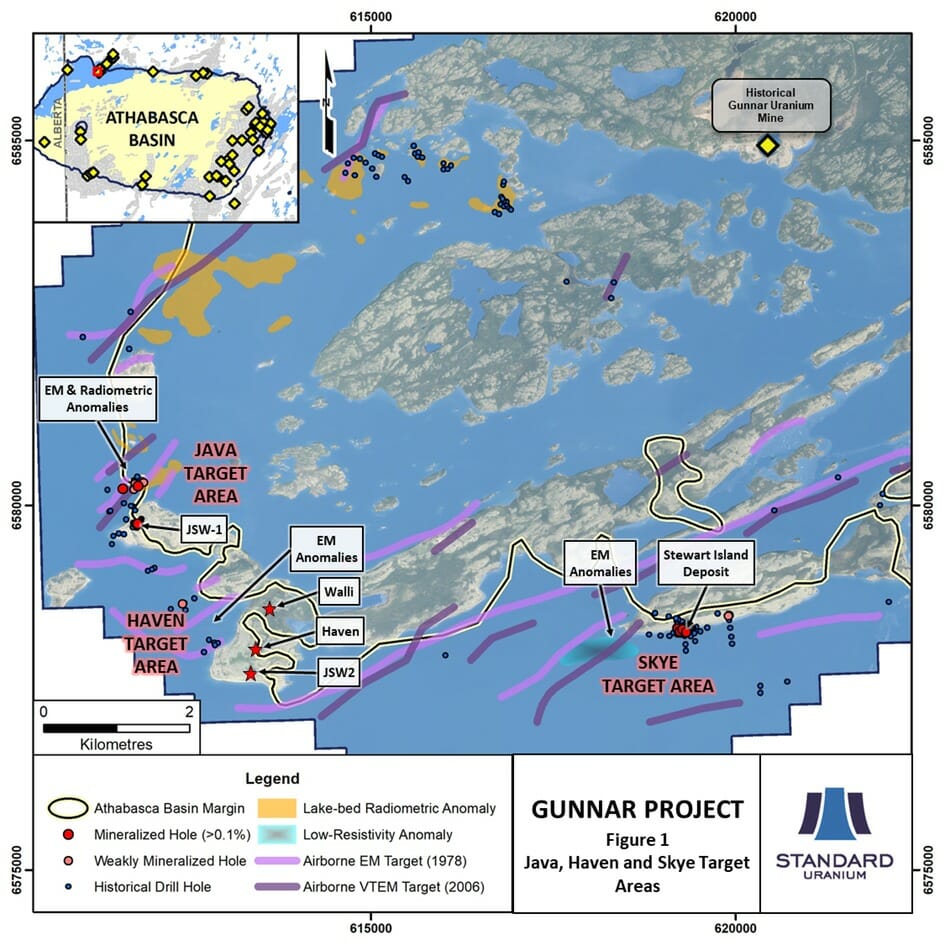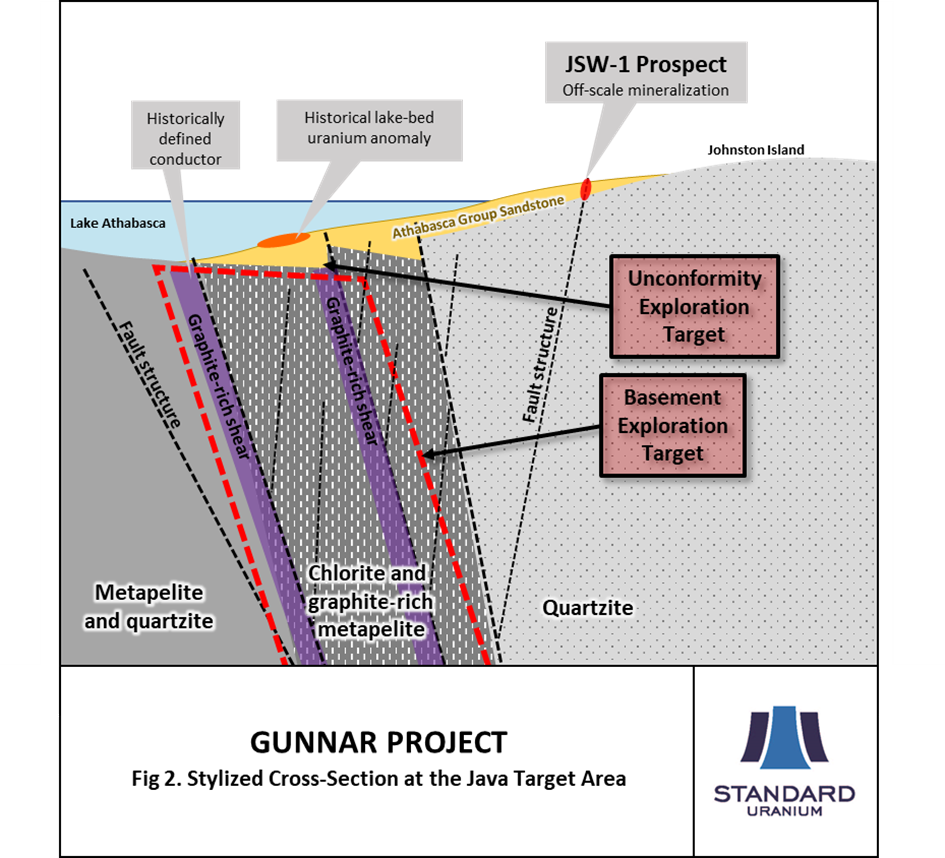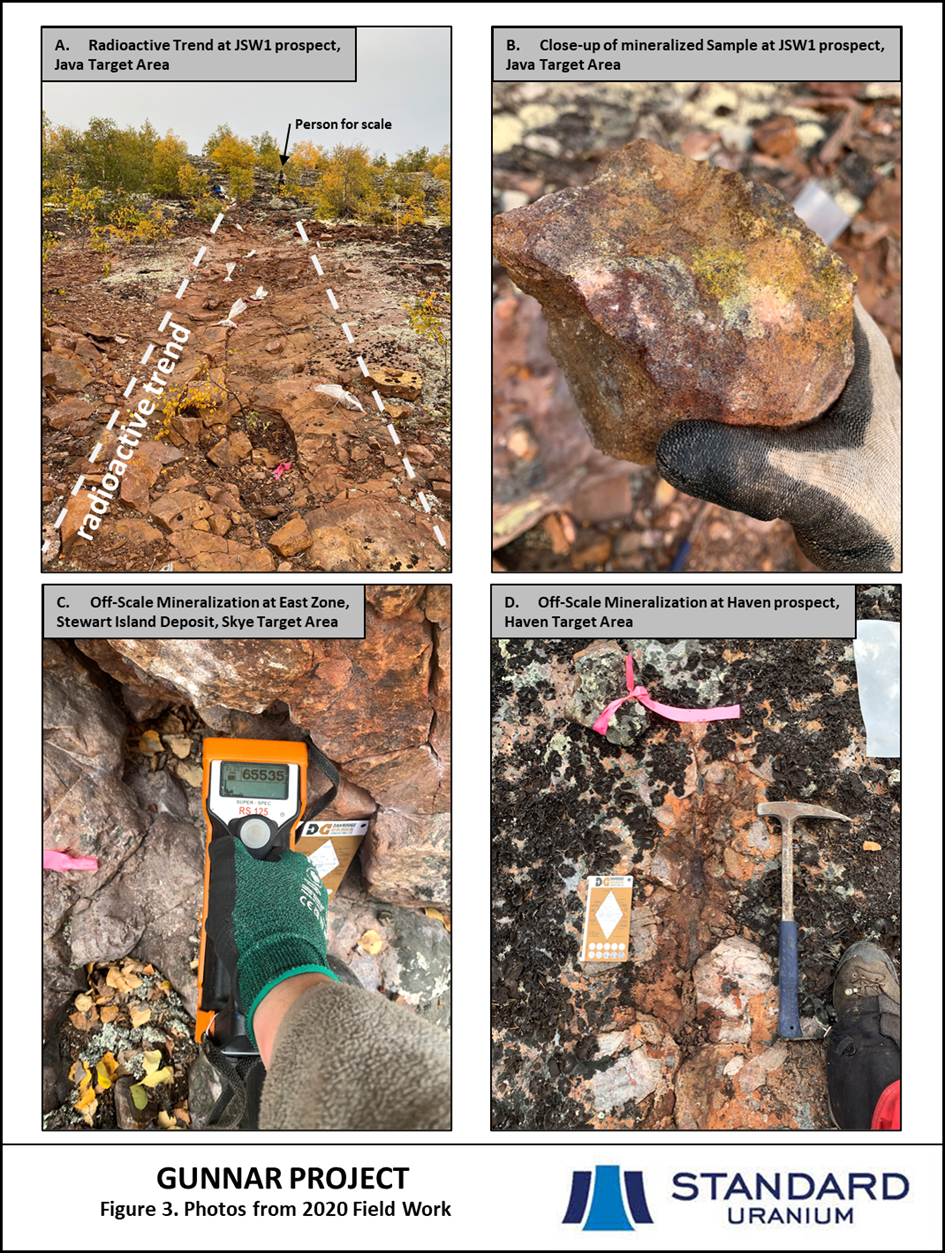Vancouver, British Columbia, September 24, 2020 — Standard Uranium Ltd. (“Standard Uranium” or the “Company”) (TSX-V: STND) (Frankfurt: FWB:9SU) is pleased to announce that off-scale uranium mineralization has been sampled at surface from historical uranium prospects at its 15,770 hectare, 100% owned, Gunnar Uranium Project (the “Project”). The Project is located at the northwest edge of the Athabasca Basin, Saskatchewan, and is south of the first uranium mining camp in Canada, the Beaverlodge District, near Uranium City.
Geologists have thus far visited the two main exploration targets on the project, the JSW1 prospect, herein re-named the “Java Target”, and the historical Stewart Island Deposit, herein re-named the “Skye Target”. In addition, a previously un-documented strongly radioactive occurrence has been located near two historically documented prospects, and the area has been collectively named the “Haven Target”. These three target areas will have a high priority, given the historically observed radioactivity at surface hosted in Athabasca Supergroup sandstones, and their proximity to nearby targets at the unconformity and within the basement rocks. (Figure 1).
As noted in the July 15, 2020 news release, the target areas at the Gunnar Project have many attributes that are favourable for the formation of high-grade unconformity-related uranium mineralization. The key geological factors include uranium-enriched bedrock, re-activated and graphitized structures, Athabasca Supergroup sandstone cover, and favourable basement rheology contrasts.

Java Target Historical Context
The Java Target at the north-west end of Johnston Island encompasses the historical JNW-1 prospect and the unconformity-related uranium target to the north The JNW-1 prospect was channel sampled in 1977 by SMDC with results of 0.43% U3O8 over 4.2 m at surface. Individual grab samples were as high as 12.4% U3O8.
Located approximately 350 metres to the north of the JNW-1 prospect is a 1.5 km long electromagnetic trend that was drill-tested by several drill holes which encountered strongly altered and brecciated, chlorite-, sulphide-, and graphite-bearing metasediments underlying the Athabasca sandstone. The best hole of the area, LAO-1, contains 0.10% U3O8 over 1 metre. (Figure 2) is a stylized representation of the exploration model at the Java target area.

2020 Follow-up at the Java Target
The Standard Uranium geologists recently re-located and sampled the historical JNW-1 prospect and defined a surface radioactivity trend that is 30-metres long and between 2 and 8 metres wide. In total, 14 samples have been collected, some of which host off-scale uranium mineralization (herein defined as >65,000 CPS with a hand-held RS-125 Spectrometer) as the samples host strong fracture-related hematite and limonite alteration; with millimeter-scale uraninite mineralization along bedding planes and fractures, locally associated with patches of yellow altered uranium oxide (Figure 3A and 3B).
Skye Target Historical Context
At the south end of Steward Island is the Stewart Island uranium deposit that was defined during exploration between 1960 and 1969. A minor small historical resource of 2,561 tons averaging 0.476% U3O8 was defined in three separate zones (*). This “perched” mineralization is hosted in a single Athabasca Supergroup sandstone horizon. A historical channel sample across the surface exposure returned 1.05% U3O8 over 2.6 m. Historical drill hole N-2 drilled at -30° dip intersected 0.9% U3O8 over 5.49 m. The Skye target area encompasses the historical Stewart Island uranium deposit in addition to the un-tested conductive rocks to the west.
2020 Follow-up at the Skye Target
The Stewart Island deposit at the Skye target is composed of three main uranium zones. The strongest surface showing at the Stewart Island deposit, the main zone, is located at the edge of the shore and was not accessible this season due to remarkably high water levels. The western zone was sampled in outcrop with radioactivity measurements as high as 20,000 CPS (with an RS-125 Spectrometer). Several radioactive boulders along the shoreline were also sampled. The Eastern zone was re-located and sampled within Athabasca Supergroup rocks which exhibit off-scale uranium mineralization (Figure 3C) (>65,000 CPS with RS-125 Spectrometer).
2020 New Haven Target Area
Approximately 2.3 kilometres southeast of the Java target area on Johnston Island, the geologists have sampled an un-documented radioactive prospect bearing strong uranium mineralization, herein named the Haven prospect. Additionally, they re-located the historical Walli and JSW2 prospects on the west end of Johnston Island. Collectively, these areas are known as the Haven Target Area. Coupled with electromagnetic geophysical targets nearby, the area represents an unconformity-related uranium exploration target, warranting a similar exploration model as the Java and Skye Target Areas.
- The JSW2 prospect is described as a 50-metre long and 0.5 to 2 metre wide radioactive trend with samples collected reaching a maximum of 9,200 CPS as measured with a hand-held RS-125 spectrometer. The sample containing the strongest mineralization was collected from a silicified and fractured sandstone with strong hematite and limonite alteration.
- The Walli prospect is described as a series of historical trenches along a 15-metre long radioactive trend. Samples collected contain radioactivity measurements up to 55,000 CPS on the hand-held RS-125 Spectrometer. The most radioactive sample was collected from a quartzite unit with strong pervasive hematite alteration.
- The Haven prospect is a previously un-documented occurrence that shows evidence of being trench-sampled in the past. Samples were collected with off-scale uranium mineralization (>65,000 CPS with a RS-125 Spectrometer). The rocks in the area are described as hematite-altered and heavily fractured Athabasca Supergroup conglomerate (Figure 3D).
Neil McCallum, P.Geol, VP Exploration for Standard Uranium commented: “The current results from the Gunnar Project are incredibly encouraging and have exceeded our expectations. We are currently planning a follow-up site visit in October and are starting the process of organizing a proposal to drill-test this winter season. The project has a sizeable amount of historical regional exploration from the 1978-1981 exploration era by SMDC (a predecessor company to Cameco), and then again briefly by CanAlaska Uranium during 2006 to 2008. Our recent reconnaissance work, in combination with the historical regional exploration work has laid the foundation for a focussed effort with a goal of making a new economic uranium discovery.”

The scientific and technical information contained in this news release has been reviewed and approved by Neil McCallum, VP Exploration and is a “Qualified Person” as defined in NI 43-101.
*The historical mineral resource estimates listed above either use categories that are not compliant with National Instrument 43-101 – Standards of Disclosure for Mineral Projects (“NI 43-101”) and cannot be compared to NI 43-101 categories, or are not current estimates as prescribed by NI 43-101, and therefore should not be relied upon. A qualified person has not done sufficient work to classify the estimates as current resources and Standard is not treating the estimates as a current resource estimate. However, the estimates are relevant to guiding the Company’s exploration plans and provide geological information regarding the type of mineralization that could be present in the Gunnar Project area.
Natural gamma radiation in outcrop and samples reported in this news release was measured in Counts Per Second (CPS) using a Radiation Solutions Inc. RS-125 gamma-ray spectrometer. The reader is cautioned that total count gamma readings may not be directly or uniformly related to uranium grades of the rock sample measured; they should be used only as a preliminary indication of the presence of radioactive minerals.
About Standard Uranium (TSX-V: STND)
We find the fuel to power a clean energy future
Standard Uranium is a mineral resource exploration company based in Vancouver, British Columbia. Since its establishment, Standard Uranium has focused on the identification and development of prospective exploration stage uranium projects in the Athabasca Basin in Saskatchewan, Canada. Standard Uranium’s Davidson River Project, in the southwest part of the Athabasca Basin, Saskatchewan, is comprised of 21 mineral claims over 25,886 hectares. The Davidson River Project is highly prospective for basement hosted uranium deposits yet remains untested by drilling despite its location along trend from recent high-grade uranium discoveries. A copy of the 43-101 Technical Report that summarizes the exploration on the Project is available for review under Standard Uranium’s SEDAR issuer profile (www.sedar.com).
For further information contact:
Jon Bey, President, Chief Executive Officer, and Chairman
550 Denman Street, Suite 200
Vancouver, BC V6G 3H1
Tel: 1 (604) 375-4488
E-mail: info@standarduranium.ca
Cautionary Statement Regarding Forward-Looking Statements
This news release includes certain information and statements about management’s view of future events, expectations, plans and prospects that constitute “forward looking statements”, which are not composed of historical facts. Forward-looking statements may be identified by such terms as “believes”, “anticipates”, “intends”, “expects”, “estimates”, “may”, “could”, “would”, “will”, or “plan”, and similar expressions. Specifically, forward looking statements in this news release include, without limitation, statements regarding: the timing and content of upcoming work programs; timing of geochemical results; geological interpretations; and estimates of market conditions. These statements involve known and unknown risks, uncertainties, and other factors that may cause actual results or events, performance, or achievements of the Company to differ materially from those anticipated or implied in such forward-looking statements. The Company believes that the expectations reflected in these forward-looking statements are reasonable, but there can be no assurance that actual results will meet management’s expectations. In formulating the forward-looking statements contained herein, management has assumed that business and economic conditions affecting the Company will continue substantially in the ordinary course and will be favourable to the Company. Factors that may cause actual results to differ materially from those anticipated by these forward looking statements include: the ability to commence and complete work on the Davidson River Project given the global COVID-19 pandemic; changes in equity markets; the Company’s ability to raise additional capital if and when necessary; and other factors as described in detail in the Company’s annual information form dated May 2, 2020 and other public filings, all of which may be viewed on SEDAR (www.sedar.com). Given these risks and uncertainties, readers are cautioned not to place undue reliance on such forward-looking statements and information, which are qualified in their entirety by this cautionary statement. Except as required by law, the Company disclaims any intention and assumes no obligation to update or revise any forward looking statements to reflect actual results, whether as a result of new information, future events, changes in assumptions, changes in factors affecting such forward looking statements or otherwise.
Neither TSX-V nor its Regulation Services Provider (as that term is defined in the policies of the TSX-V) accepts responsibility for the adequacy or accuracy of this release.
